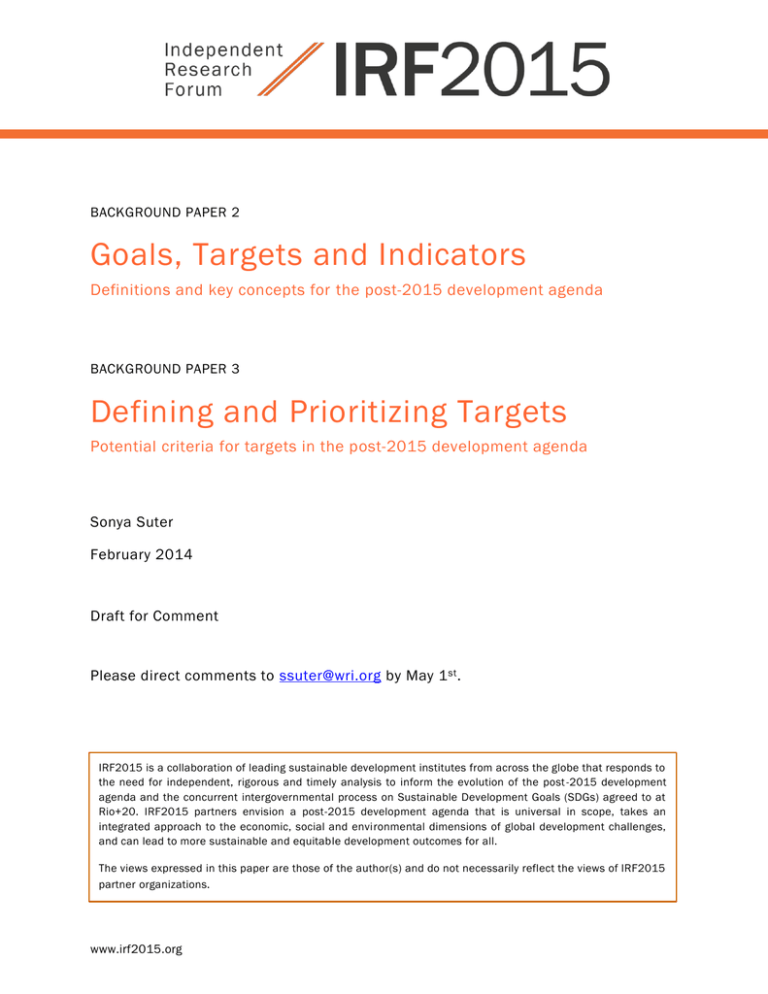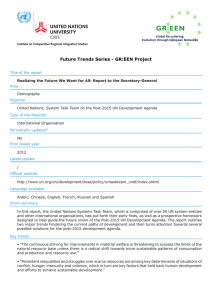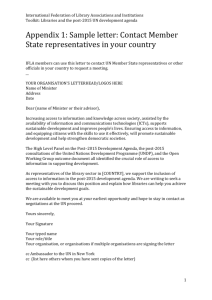Goals, Targets and Indicators Defining and Prioritizing Targets
advertisement

BACKGROUND PAPER 2 Goals, Targets and Indicators Definitions and key concepts for the post-2015 development agenda BACKGROUND PAPER 3 Defining and Prioritizing Targets Potential criteria for targets in the post-2015 development agenda Sonya Suter February 2014 Draft for Comment Please direct comments to ssuter@wri.org by May 1 st . IRF2015 is a collaboration of leading sustainable development institutes from across the globe that responds to the need for independent, rigorous and timely analysis to inform the evolution of the post -2015 development agenda and the concurrent intergovernmental process on Sustainable Development Goals (SDGs) agreed to at Rio+20. IRF2015 partners envision a post-2015 development agenda that is universal in scope, takes an integrated approach to the economic, social and environmental dimensions of global development challenges, and can lead to more sustainable and equitable development outcomes for all. The views expressed in this paper are those of the author(s) and do not necessarily reflect the views of IRF2015 partner organizations. www.irf2015.org Back gr o und P a pe r 2 Goa ls , Ta rg et s and Ind i cat o rs The post-2015 development agenda will likely comprise an overarching narrative and accompanying framework of goals, targets and indicators. A goal framework, if well-formulated, has several key attributes: It is aspirational and specifies desired results (outcomes): it provides information on what specific results are needed to achieve a shared objective. It is easy to understand: there is a clear and intuitive link between goals, targets and indicators which can be clearly communicated. It is time-bound: a date of completion is delineated. Attribute Goal Target Indicator Key definition Aspiration: An ambitious commitment to address a single challenge. Action: A specific, measurable and time-bound outcome (result) that directly contributes to achievement of a goal. Accountability for results: A metric used to measure progress towards a target; generally based on available or established data. Quantitative or Qualitative Qualitative or quantitative Quantitative Quantitative Scope Global Global or national; may be aggregated to assess global progress Global or national; may be aggregated to assess national or global progress Examples Achieve universal primary education Ensure that, by 2030, children everywhere, boys and girls alike, will be able to complete a full course of primary schooling Net enrollment ratio for in primary education Literacy rate of 15-24 year olds Reduce child mortality Eradicate under-five mortality Infant mortality rate Under-five mortality rate Ensure food security and good nutrition Reduce post-harvest loss and food waste by 50% by 2030 Share of agricultural produce loss and food waste The potential number of targets under a comprehensive post-2015 goal framework is large, and needs to be considered against data availability, the cost of data collection, and capacity requirements for both data collection and analysis. Key questions: What is the optimal number of targets for the post-2015 development agenda? How to prioritize between potential targets? How can targets be differentiated between countries in different circumstances? How to account for inter-linkages across targets (‘integrating approach’)? www.irf2015.org 1 Back gr o und P a pe r 2 Goa ls , Ta rg et s and Ind i cat o rs Background material on definitions from three post-2015 proposals: High Level Panel for a Post1 2015 Development Agenda Sustainable Development 2 Solutions Network Proposal 12 goals, 54 targets 10 goals, 30 targets Goal Expresses an ambitious, but specific commitment. Always starts with a verb/action. Each goal should be an ambitious commitment that presents a single challenge with great impact. It should be universal, comprehensive, operational, and easy to understand. Goals should address common but differentiated responsibilities. They should create a more coherent global approach by framing global goals… Target Quantified sub-components that will contribute in a major way to achievement of goal. Should be an outcome variable. A specific, measurable, attainable, time-bound outcome that contributes to the achievement of a goal. It should be defined at global and national levels to reflect each country’s ambitions and capacities. …but leave individual countries to devise ambitious targets based on their national contexts. Ideally, goals should be focused on outcomes, but in some cases, input, output or process goals and targets could be appropriate. An indicator is a meaningful, simple, and quantifiable metric used to assess progress toward meeting a target. It should be easily and quickly measurable and should allow for disaggregation. Indicators are accessible to sophisticated lay reader. Indicators measure outputs rather than inputs. Broad, summative indicators that reflect whole sector outcomes are preferred over indicators that assess only a narrow element of the overall goal. Agreed upon indicators from relevant international organizations are exploited. Direct measures are preferred over indices or derived variables. Direct measures are preferred to ones based on perceptions. Specifies level of ambition of each country; may be universal in specific circumstances. Indicator Precise metric from identified databases to assess if target is being met (often multiple indicators are used). Center for International Governance Innovation and 3 Korea Development Institute 11 goals, 83 indicators (no targets included) Endnotes 1 The High Level Panel of Eminent Persons on a Post-2015 Development Agenda, A New Global Partnership: Eradicate Poverty and Transform Economies through Sustainable Development. 2 Sustainable Development Solutions Network, An Action Agenda for Sustainable Development and “Issue Brief: Goals, Targets, and Indicators for Sustainable Agriculture.” 3 Center for International Governance Innovation and the Korea Development Institute, Post-2015 Development Agenda: Goals, Targets and Indicators: Special Report. www.irf2015.org 2 Back gr o und P a pe r 3 Def in ing a nd P ri o rit i z in g T ar get s 1. Introduction A key challenge in crafting the post-2015 development agenda will be balancing the need to capture the full range and complexity of development issues facing society with the need to put forwa rd a focused, concrete and easy-to-understand goal framework. Although criticized for neglecting important issues, the MDGs for example have 8 goals with a total of 21 targets. Recent proposals for post -2015 goal frameworks have on average 10 to 12 goals, with a total of approximately 30 -50 targets. Selecting the right post-2015 goals will be a crucially important task, but equally if not more important, it will be critical to define and prioritize those targets that will stimulate the policies and investments needed to help achieve the next set of sustainable development goals. UN organizations and other stakeholders have identified various criteria for use in selecting targets for sustainable development generally, and the post-2015 development agenda in particular. The following is an illustrative list drawn up to assist UN Member States in identifying the most important of many potential criteria. During the Tarrytown retreat (9-10 February 2014), we will explore what this means for designing and selecting targets in the context of the post-2015 goal framework. 2. Criteria for designing well-defined targets Quantitative: aims for a specific value (numeric, rate of change or absolute – e.g. ‘zero goals’) Time-bound: specifies the year of attainment (preferably uniform across targets , and with a common baseline year) Ambitious: aspires to a greater improvement than what would otherwise be expected in the absence of the development agenda Attainable: does not suppose unrealistic progress in the time allotted Policy relevant: has a clear relationship to the goal(s) to which it contributes – and results or trends can inform policy responses 3. Criteria for selecting and prioritizing amongst possible targets Transformational: achieving the target is an essential “must have” to meeting one or m ore goals Supports multiple dimensions of sustainable development: clearly links to the three dimensions of sustainable development (economic, social, environmental), and potentially can support achievement of more than one goal Results-oriented: aims for an outcome, not an input or output (e.g. literacy rate compared to years spent in school) Reflects existing commitments: incorporates and is otherwise consistent with current international agreements (e.g. Convention on Biodiversity or Hyogo Fra mework for Action) as appropriate www.irf2015.org 3 Back gr o und P a pe r 3 Def in ing a nd P ri o rit i z in g T ar get s Additionally, targets should take into account the following implementation and measurement considerations: Disaggregated (or able to be disaggregated) amongst sub-groups: information on a target could be assessed by gender, race, ethnicity or other divisions to ensure that progress is shared evenly Defined (or able to be defined) at the country level: can be specific to a location or tailored to local circumstances Based on available data: sources of information are known and data can be collected to assess progress, taking into account varying technical capacities Incorporating new data: leverages advances in metrics and data collection technologies Comparable to a baseline: the starting point is known and defined Assessed globally: data from many countries can be aggregated to assess global progress Cost-effective: costs do not outweigh benefits of collecting needed data References Center for International Governance Innovation and the Korea Development Institute, Post-2015 Development Agenda: Goals, Targets and Indicators: Special Report, October 2012. Green Growth Knowledge Platform, Moving Toward a Common Approach on Green Growth Indicators, April 2013. The High Level Panel of Eminent Persons on a Post-2015 Development Agenda, A New Global Partnership: Eradicate Poverty and Transform Economies through Sustainable Development , May 2013. Schweinfest, Stefan (UN Statistics Division), “Statistics and Indicators for the Post -2015 Development Agenda,” Presented on November 26, 2013. Sustainable Development Solutions Network, An Action Agenda for Sustainable Development, May 2013. Sustainable Development Solutions Network, “Goals, Targets, and Indicators for Sustainable Agricult ure,” December 2013. UN System Task Team on the Post-2015 UN Development Agenda, Statistics and Indicators for the Post2015 Development Agenda, July 2013. UNECE/Eurostat/OECD Task Force on Measuring Sustainable Development, Framework and Suggested Indicators to Measure Sustainable Development, June 2013. UN Economic Commission for Africa, Working Document on the New Development Indicators Reflecting the Realities, Needs, and Priorities in Monitoring Human and Social Development in Africa Beyond 2015, December 2012. www.irf2015.org 4



